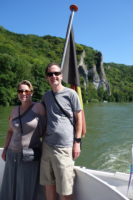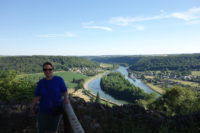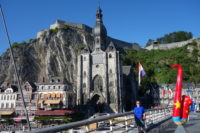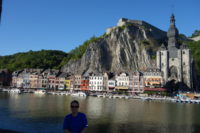 Sometimes, I do judge a book by its cover. When I was researching places to go during my time of being in charge in Belgium, I had decided on going to the southeast of the country to the area around Spa (the town responsible for the English word “spa”). Somehow, when I was looking something up, I saw a picture of Dinant, with colorful houses, a large stone church, and a towering cliff with a fort on top. As soon as I saw that, I changed all of my plans. That is how we ended up in Dinant today after a two(ish)-hour drive from Bruges.
Sometimes, I do judge a book by its cover. When I was researching places to go during my time of being in charge in Belgium, I had decided on going to the southeast of the country to the area around Spa (the town responsible for the English word “spa”). Somehow, when I was looking something up, I saw a picture of Dinant, with colorful houses, a large stone church, and a towering cliff with a fort on top. As soon as I saw that, I changed all of my plans. That is how we ended up in Dinant today after a two(ish)-hour drive from Bruges.
Our hotel is great – a small four-room place with a common kitchen that has large windows that overlook the River Meuse. We might be seventy-five feet from the water – just a street and cafe seating away. The only downside is that because our room faces the river, it also got the full afternoon sun, so it felt as if our room was at least eighty degrees. It is not surprising that a country that is usually in the upper sixties in July does not have air conditioning, but it was hot. Happily, the owner got us a fan, which will work with Belgium’s cool nights.
After a quick lunch in our convenient hotel, we took a two-hour river cruise on the Meuse. We headed upstream, and the countryside ranged from pleasant (gentle hills and cute houses) to amazing (sculptured gardens and sheer cliffs with people climbing on them). We got to go through a modern-day lock that brought us up about six feet to the higher stretch of the river, and I loved that. We stayed in the shade on board, which was a good thing on an intensely sunny day like today, and we were entertained by the ramblings of several little girls running around chattering in French. The cruise was a good use of time, and helped rest our legs that had been walking about eight or nine miles a day this vacation.
 By the time the cruise had ended, it was too late to climb up to the citadel. It was 5:00, and the fort closed at 6:00. We do not generally like to rush through touring things. So, instead, since I had a car, we drove about five miles to the nearby town of Yvoir, up into the hills along one-lane roads, to get to the ruined fortress of Poilvache, which had been destroyed by an army around 1430. It had commanding views of the Meuse and countryside, had ruined towers and parts of a defensive moat, and it closed at 6:00. We got there at 6:05. Happily, a very polite man told us to feel free to take pictures from the lookout next to the cafe, but we did not get to see the castle itself. Maybe tomorrow.
By the time the cruise had ended, it was too late to climb up to the citadel. It was 5:00, and the fort closed at 6:00. We do not generally like to rush through touring things. So, instead, since I had a car, we drove about five miles to the nearby town of Yvoir, up into the hills along one-lane roads, to get to the ruined fortress of Poilvache, which had been destroyed by an army around 1430. It had commanding views of the Meuse and countryside, had ruined towers and parts of a defensive moat, and it closed at 6:00. We got there at 6:05. Happily, a very polite man told us to feel free to take pictures from the lookout next to the cafe, but we did not get to see the castle itself. Maybe tomorrow.
 Back in Dinant, we walked to and over the Saxophone-speckled Pont Charles de Gaulle bridge, where you get amazing views of the town and citadel. Why saxophones? Albert Sax, the inventor, was born in Dinant, so there are large saxophone sculptures everywhere.
Back in Dinant, we walked to and over the Saxophone-speckled Pont Charles de Gaulle bridge, where you get amazing views of the town and citadel. Why saxophones? Albert Sax, the inventor, was born in Dinant, so there are large saxophone sculptures everywhere.
We followed signs to the 23 August 1914 memorial. Dinant was on the front line early in WW I, and Germany’s advance was checked in this area by French troops. In retaliation, the Germans accused the town of being French supporters, and promptly executed more than six hundred men, women, and children, before sending the remaining men off to a concentration camp. The memorial is a diamond-shaped tunnel of iron with the names of all the victims cut into it backwards, so they can be read correctly as you walk through the memorial. On the outside, in normal text, are multiple quotes in French about peace. It was very moving.
 We walked back into town and got take-out food for supper. Why pay for the restaurant view that we already have? We have all day tomorrow to explore the region before I close the cover of the Dinant book that has opened so well (assuming we find things open, that is).
We walked back into town and got take-out food for supper. Why pay for the restaurant view that we already have? We have all day tomorrow to explore the region before I close the cover of the Dinant book that has opened so well (assuming we find things open, that is).